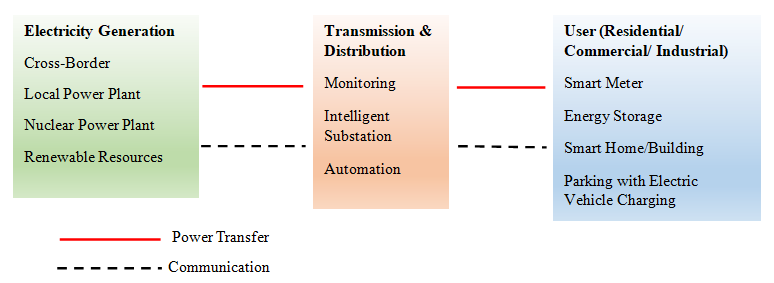Smart Grid: A Step Toward Smart City
Written by Abhishek Kumar and Ishan Srivastava
Improvement in the quality of life and rapid growth across urban regions drives administrators, urban planners, and architects alike to focus on shaping smart cities. One of the incentives for making a city smarter is to facilitate monitoring and optimization of its natural resources, including water and renewable energy, as well as man-made resources like power, infrastructure, and smart buildings, without harming the environment. Smart cities utilize recent advances in technologies for resource optimization. One of the most significant attributes of a smart city is the efficient utilization of electrical energy. Smart Grid (SG) makes use of Information and Communication Technology (ICT) solutions to optimize electrical energy and reduce the losses.
Introduction
The United Nations estimated that there would be a growth of 63% in urban population from 2015 to 2050, such that most of the increment will be observed in developing countries, mostly across Asia and Africa. This increase in urbanization is due to migration from rural areas to cities and the shifting of people from economically poor countries to developed/developing countries. It is estimated that the population growth across metropolitan cities like Mumbai and New Delhi will reach 42 million and 36 million by 2050, respectively. Almost 50% of the world’s population lives in urban cities, which cover only 2% of the earth’s surface, consume 75% of the total energy produced, and contribute to 80% of total greenhouse gas emission [1]. Looking at these issues, urban planners and other authorities thought of smart cities to optimize available resources and mitigate socio-economic imbalance, as well as to support nature preservation. A smart city is a self-sustainable city that manages all the resources and waste caused by the inhabitant without spoiling the environment. The main concept of any smart city is related to ICT and with the exponential advancement in ICT solutions, smart cities are now a reality with lots of scope for improvement. One scope of improvement is to utilize electricity most efficiently, as electrical energy is one of the key factors for any city.
Smart Grid and its Role in a Smart City
Traditional energy distribution is unidirectional, with static tariff and uses simple meters to record power consumption [2]. Thus, there is a lack of bidirectional information sharing in a normal grid structure. However, with the involvement of ICT, sensors, and smart meters within the grid structure we can have bidirectional sharing of information between the grid and users that leads to the concept of smart grid. A smart grid can be defined as an integration of ICT and control technologies, along with sensors that combine various services, products, and technologies with generating, transmitting, and distributing grids [3]. Figure 1 shows a schematic for a concept of a smart grid. A SG has capability to supply electrical power from various sources, such as solar photovoltaic, wind energy, and plug-in hybrid electric vehicles [4]. SG uses a communication channel along with power transmission line to establish two-way communication among all the equipment. It utilizes automation, monitoring, self-controlling and smart and intelligent devices, like smart meter and intelligent substation [5,6].
Figure 1: Smart Grid Structure.
SG offers a variety of advantages to consumers and utility companies. Some of the advantages are reduction in utility bills, utilizing various renewable resources, lowering peak demand, reduction in greenhouse gas emission, increasing reliability of the system, improvement in power quality, and many more. The main features of SGs that make it an integrated part of any smart city are:
- Motivating Clean Energy: SG supports integration of distributed renewable energy resources (RES) and results in clean and reliable electrical energy to the inhabitants, which is a key feature of any smart city.
- Smart Metering: Advanced metering infrastructure (AMI), owing to its bi-directional communication and data reading capability, allows customers to implement dynamic tariffs to balance the load under critical conditions by stimulating a combination of electric vehicle (EV) and RES. AMI also enables operators to forecast load.
- Integrating Electric Vehicles: One of the major sources of air pollution and hence health issues in urban areas is the use of fuel based vehicles. Use of EVs and plug-in hybrid electric vehicles (PHEV) can reduce air pollution. Managing battery charging can handle surplus energy obtained from RES and can avoid overloading of the network, thus optimizing clean energy.
- Involvement of Inhabitants: SG is customer oriented and assists its customers in decision-making concerning power usage. Integration of EVs/PHEVs and other small RES can transfer electrical energy to the grid under crucial conditions/peak load.
To achieve the goals discussed above, a SG must be established on three levels: Physical infrastructure, ICT infrastructure, and Standardization.
Conclusion
A smart city highly depends on an intelligent electrical network to ensure a reliable, clean, and safe electrical power supply. This kind of network can be achieved by the use of SG. A SG achieves aforementioned power supply by integrating ICT, along with controlling tool and advanced sensors. Bi-directional communication in SG makes it possible for consumers to give back electrical energy (through EVs/PHEVs or energy stored through RES) into the grid under peak hour/critical conditions. Moreover, machine learning is also being used by researchers to optimize the working of SGs. This paper studied the impact of SG in Oman. From the studies, it can be concluded that smart grids are the future for electrical power generation, transmission, and distribution and that they play a vital role in the planning of any smart city.
References
- M. Eremia, L. Toma and M. Sanduleac, “The Smart City Concept in The 21st Century,” Procedia Engineering, 181, 12-19, 2017.
- M. Farmanbar, K. Parham, Ø. Arild and C. Rong, “A Widespread Review of Smart Grids towards Smart Cities,” Energies, 12(23), 4484, 2019.
- O.S. Neffati, S. Sengan, K.D. Thangavelu, S. D.Kumar, R. Setiawan, M. Elangovan and P. Velayutham, “Migrating From Traditional Grid to Smart Grid in Smart Cities Promoted in Developing Country,” Sustainable Energy Technologies and Assessments, 45, 101125, 2021.
- A.H. Al-Badi. R. Ahshan, N. Hosseinzadeh, R. Ghorbani, and E. Hossain, “Survey of Smart Grid Concepts and Technological Demonstrations Worldwide Emphasizing on The Oman Perspective,” Applied system innovation, 3(1), 5, 2020.
- S. Tiwari, A. Jain, N. M. O. S. Ahmed, L. M. Alkwai, A. K. Y. Dafhalla and S.A.S. Hamad, “Machine Learning‐Based Model for Prediction of Power Consumption In Smart Grid‐Smart Way Towards Smart City,” Expert Systems, 39(5), e12832, 2022.
- O.A. Omitaomu and H. Niu, “Artificial Intelligence Techniques in Smart Grid: A Survey,” Smart Cities, 4(2), 548-568, 2021.
This article was edited by Sidharth Sabyasachi.
To view all articles in this issue, please go to March 2023 eNewsletter. For a downloadable copy, please visit the IEEE Smart Cities Resource Center.


To have the eNewsletter delivered monthly to your inbox, join the IEEE Smart Cities Community.
Past Issues
To view archived articles, and issues, which deliver rich insight into the forces shaping the future of the smart cities. Older eNewsletter can be found here. To download full issues, visit the publications section of the IEEE Smart Cities Resource Center.




